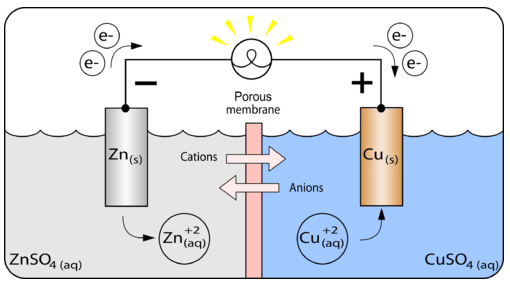23.3: Voltaic Cells
- Page ID
- 53969
\( \newcommand{\vecs}[1]{\overset { \scriptstyle \rightharpoonup} {\mathbf{#1}} } \)
\( \newcommand{\vecd}[1]{\overset{-\!-\!\rightharpoonup}{\vphantom{a}\smash {#1}}} \)
\( \newcommand{\dsum}{\displaystyle\sum\limits} \)
\( \newcommand{\dint}{\displaystyle\int\limits} \)
\( \newcommand{\dlim}{\displaystyle\lim\limits} \)
\( \newcommand{\id}{\mathrm{id}}\) \( \newcommand{\Span}{\mathrm{span}}\)
( \newcommand{\kernel}{\mathrm{null}\,}\) \( \newcommand{\range}{\mathrm{range}\,}\)
\( \newcommand{\RealPart}{\mathrm{Re}}\) \( \newcommand{\ImaginaryPart}{\mathrm{Im}}\)
\( \newcommand{\Argument}{\mathrm{Arg}}\) \( \newcommand{\norm}[1]{\| #1 \|}\)
\( \newcommand{\inner}[2]{\langle #1, #2 \rangle}\)
\( \newcommand{\Span}{\mathrm{span}}\)
\( \newcommand{\id}{\mathrm{id}}\)
\( \newcommand{\Span}{\mathrm{span}}\)
\( \newcommand{\kernel}{\mathrm{null}\,}\)
\( \newcommand{\range}{\mathrm{range}\,}\)
\( \newcommand{\RealPart}{\mathrm{Re}}\)
\( \newcommand{\ImaginaryPart}{\mathrm{Im}}\)
\( \newcommand{\Argument}{\mathrm{Arg}}\)
\( \newcommand{\norm}[1]{\| #1 \|}\)
\( \newcommand{\inner}[2]{\langle #1, #2 \rangle}\)
\( \newcommand{\Span}{\mathrm{span}}\) \( \newcommand{\AA}{\unicode[.8,0]{x212B}}\)
\( \newcommand{\vectorA}[1]{\vec{#1}} % arrow\)
\( \newcommand{\vectorAt}[1]{\vec{\text{#1}}} % arrow\)
\( \newcommand{\vectorB}[1]{\overset { \scriptstyle \rightharpoonup} {\mathbf{#1}} } \)
\( \newcommand{\vectorC}[1]{\textbf{#1}} \)
\( \newcommand{\vectorD}[1]{\overrightarrow{#1}} \)
\( \newcommand{\vectorDt}[1]{\overrightarrow{\text{#1}}} \)
\( \newcommand{\vectE}[1]{\overset{-\!-\!\rightharpoonup}{\vphantom{a}\smash{\mathbf {#1}}}} \)
\( \newcommand{\vecs}[1]{\overset { \scriptstyle \rightharpoonup} {\mathbf{#1}} } \)
\( \newcommand{\vecd}[1]{\overset{-\!-\!\rightharpoonup}{\vphantom{a}\smash {#1}}} \)
\(\newcommand{\avec}{\mathbf a}\) \(\newcommand{\bvec}{\mathbf b}\) \(\newcommand{\cvec}{\mathbf c}\) \(\newcommand{\dvec}{\mathbf d}\) \(\newcommand{\dtil}{\widetilde{\mathbf d}}\) \(\newcommand{\evec}{\mathbf e}\) \(\newcommand{\fvec}{\mathbf f}\) \(\newcommand{\nvec}{\mathbf n}\) \(\newcommand{\pvec}{\mathbf p}\) \(\newcommand{\qvec}{\mathbf q}\) \(\newcommand{\svec}{\mathbf s}\) \(\newcommand{\tvec}{\mathbf t}\) \(\newcommand{\uvec}{\mathbf u}\) \(\newcommand{\vvec}{\mathbf v}\) \(\newcommand{\wvec}{\mathbf w}\) \(\newcommand{\xvec}{\mathbf x}\) \(\newcommand{\yvec}{\mathbf y}\) \(\newcommand{\zvec}{\mathbf z}\) \(\newcommand{\rvec}{\mathbf r}\) \(\newcommand{\mvec}{\mathbf m}\) \(\newcommand{\zerovec}{\mathbf 0}\) \(\newcommand{\onevec}{\mathbf 1}\) \(\newcommand{\real}{\mathbb R}\) \(\newcommand{\twovec}[2]{\left[\begin{array}{r}#1 \\ #2 \end{array}\right]}\) \(\newcommand{\ctwovec}[2]{\left[\begin{array}{c}#1 \\ #2 \end{array}\right]}\) \(\newcommand{\threevec}[3]{\left[\begin{array}{r}#1 \\ #2 \\ #3 \end{array}\right]}\) \(\newcommand{\cthreevec}[3]{\left[\begin{array}{c}#1 \\ #2 \\ #3 \end{array}\right]}\) \(\newcommand{\fourvec}[4]{\left[\begin{array}{r}#1 \\ #2 \\ #3 \\ #4 \end{array}\right]}\) \(\newcommand{\cfourvec}[4]{\left[\begin{array}{c}#1 \\ #2 \\ #3 \\ #4 \end{array}\right]}\) \(\newcommand{\fivevec}[5]{\left[\begin{array}{r}#1 \\ #2 \\ #3 \\ #4 \\ #5 \\ \end{array}\right]}\) \(\newcommand{\cfivevec}[5]{\left[\begin{array}{c}#1 \\ #2 \\ #3 \\ #4 \\ #5 \\ \end{array}\right]}\) \(\newcommand{\mattwo}[4]{\left[\begin{array}{rr}#1 \amp #2 \\ #3 \amp #4 \\ \end{array}\right]}\) \(\newcommand{\laspan}[1]{\text{Span}\{#1\}}\) \(\newcommand{\bcal}{\cal B}\) \(\newcommand{\ccal}{\cal C}\) \(\newcommand{\scal}{\cal S}\) \(\newcommand{\wcal}{\cal W}\) \(\newcommand{\ecal}{\cal E}\) \(\newcommand{\coords}[2]{\left\{#1\right\}_{#2}}\) \(\newcommand{\gray}[1]{\color{gray}{#1}}\) \(\newcommand{\lgray}[1]{\color{lightgray}{#1}}\) \(\newcommand{\rank}{\operatorname{rank}}\) \(\newcommand{\row}{\text{Row}}\) \(\newcommand{\col}{\text{Col}}\) \(\renewcommand{\row}{\text{Row}}\) \(\newcommand{\nul}{\text{Nul}}\) \(\newcommand{\var}{\text{Var}}\) \(\newcommand{\corr}{\text{corr}}\) \(\newcommand{\len}[1]{\left|#1\right|}\) \(\newcommand{\bbar}{\overline{\bvec}}\) \(\newcommand{\bhat}{\widehat{\bvec}}\) \(\newcommand{\bperp}{\bvec^\perp}\) \(\newcommand{\xhat}{\widehat{\xvec}}\) \(\newcommand{\vhat}{\widehat{\vvec}}\) \(\newcommand{\uhat}{\widehat{\uvec}}\) \(\newcommand{\what}{\widehat{\wvec}}\) \(\newcommand{\Sighat}{\widehat{\Sigma}}\) \(\newcommand{\lt}{<}\) \(\newcommand{\gt}{>}\) \(\newcommand{\amp}{&}\) \(\definecolor{fillinmathshade}{gray}{0.9}\)Luigi Galvani (1737-1798) was an Italian physician and scientist who did research on nerve conduction in animals. His accidental observation of the twitching of frog legs when they were in contact with an iron scalpel, while the legs hung on copper hooks, led to studies on electrical conductivity in muscles and nerves. He believed that animal tissues contained an "animal electricity" similar to the natural electricity that caused lightning to form.
Voltaic Cells
A voltaic cell is an electrochemical cell that uses a spontaneous redox reaction to produce electrical energy.

The voltaic cell (see figure above) consists of two separate compartments. A half-cell is one part of a voltaic cell in which either the oxidation or reduction half-reaction takes place. The left half-cell is a strip of zinc metal in a solution of zinc sulfate. The right half-cell is a strip of copper metal in a solution of copper (II) sulfate. The strips of metal are called electrodes. An electrode is a conductor in a circuit that is used to carry electrons to a nonmetallic part of the circuit. The nonmetallic part of the circuit is the electrolyte solution in which the electrodes are placed. A metal wire connects the two electrodes. A switch opens or closes the circuit. A porous membrane is placed between the two half-cells to complete the circuit.
The various electrochemical processes that occur in a voltaic cell occur simultaneously. It is easiest to describe them in the following steps, using the above zinc-copper cell as an example.
1. Zinc atoms from the zinc electrode are oxidized to zinc ions. This happens because zinc is higher than copper on the activity series, and so is more easily oxidized.
\[\ce{Zn} \left( s \right) \rightarrow \ce{Zn^{2+}} \left( aq \right) + 2 \ce{e^-}\nonumber \]
The electrode at which oxidation occurs is called the anode. The zinc anode gradually diminishes as the cell operates, due to the loss of zinc metal. The zinc ion concentration in the half-cell increases. Because of the production of electrons at the anode, it is labeled as the negative electrode.
2. The electrons that are generated at the zinc anode travel through the external wire and register a reading on the voltmeter. They continue to the copper electrode.
3. Electrons enter the copper electrode where they combine with the copper (II) ions in the solution, reducing them to copper metal.
\[\ce{Cu^{2+}} \left( aq \right) + 2 \ce{e^-} \rightarrow \ce{Cu} \left( s \right)\nonumber \]
The electrode at which reduction occurs is called the cathode. The cathode gradually increases in mass because of the production of copper metal. The concentration of copper (II) ions in the half-cell solution decreases. The cathode is the positive electrode.
4. Ions move through the membrane to maintain electrical neutrality in the cell. In the cell illustrated above, sulfate ions will move from the copper side to the zinc side to compensate for the decrease in \(\ce{Cu^{2+}}\) and the increase in \(\ce{Zn^{2+}}\).
The two half-reactions can again be summed to provide the overall redox reaction occurring in the voltaic cell:
\[\ce{Zn} \left( s \right) + \ce{Cu^{2+}} \left( aq \right) \rightarrow \ce{Zn^{2+}} \left( aq \right) + \ce{Cu} \left( s \right)\nonumber \]
Summary
- A voltaic cell is an electrochemical cell that uses a spontaneous redox reaction to produce electrical energy.
- The structure of a voltaic cell includes two half-cells; each being one part of a voltaic cell in which either the oxidation or reduction half-reaction takes place, and each containing an electrode.
- The electrode at which oxidation occurs is called the anode.
- The electrode at which reduction occurs is called the cathode.
- The reactions producing electron flow are given.

